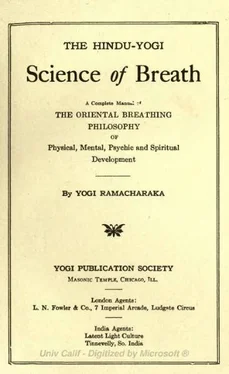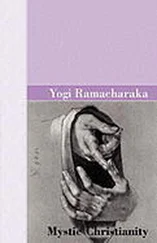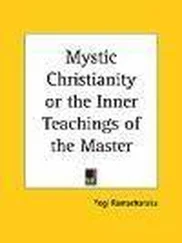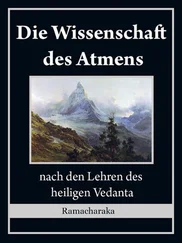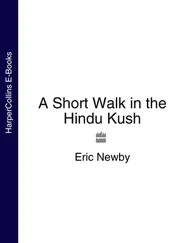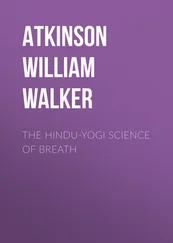(6) Repeat a number of times, but avoid fatiguing yourself at the start.
(7) When you are ready to close the exercise, practice the cleansing breath, which will rest you and cleanse the lungs.
After a little practice you will be able to increase the duration of the inhalations and exhalations, until about fifteen pulse units are consumed. In this increase, remember that the units for retention and between breaths is one-half the units for inhalation and exhalation.
Do not overdo yourself in your effort to increase the duration of the breath, but pay as much attention as possible to acquiring the "rhythm," as that is more important than the length of the breath. Practice and try until you get the measured "swing" of the movement, and until you can almost "feel" the rhythm of the vibratory motion throughout your whole body. It will require a little practice and perseverance, but your pleasure at your improvement will make the task an easy one. The Yogi is a most patient and persevering man, and his great attainments are due largely to the possession of these qualities.
CHAPTER XIV. PHENOMENA OF YOGI PSYCHIC BREATHING.
With the exception of the instructions in the Yogi Rhythmic Breathing, the majority of the exercises heretofore given in this book relate to the physical plane of effort, which, while highly important in itself, is also regarded by the Yogis as in the nature of affording a substantial basis for efforts on the psychic and spiritual plane. Do not, however, discard or think lightly of the physical phase of the subject, for remember that it needs a sound body to support a sound mind, and also that the body is the temple of the Ego, the lamp in which burns the light of the Spirit. Everything is good in its place, and everything has its place. The developed man is the "all-around man," who recognizes body, mind and spirit and renders to each its due. Neglect of either is a mistake which must be rectified sooner or later; a debt which must be repaid with interest.
We will now take up the Psychic phase of the Yogi Science of Breath in the shape of a series of exercises, each exercise carrying with it its explanation.
You will notice that in each exercise rhythmic breathing is accompanied with the instructions to "carry the thought" of certain desired results. This mental attitude gives the Will a cleared track upon which to exercise its force. We cannot, in this work, go into the subject of the power of the Will, and must assume that you have some knowledge of the subject. If you have no acquaintance with the subject, you will find that the actual practice of the exercises themselves will give you a much clearer knowledge than any amount of theoretical teaching, for as the old Hindu proverb says, "He who tastes a grain of mustard seed knows more of its flavor than he who sees an elephant load of it."
(1) GENERAL DIRECTIONS FOR YOGI PSYCHIC BREATHING.
The basis of all Yogi Psychic Breathing is the Yogi Rhythmic Breath, instruction regarding which we gave in our last chapter. In the following exercises, in order to avoid useless repetition, we will say merely, "Breathe Rhythmically," and then give the instruction for the exercise of the psychic force, or directed Will power working in connection with the rhythmic breath vibrations. After a little practice you will find that you will not need to count after the first rhythmic breath, as the mind will grasp the idea of time and rhythm and you will be able to breathe rhythmically at pleasure, almost automatically. This will leave the mind clear for the sending of the psychic vibrations under the direction of the Will. (See the following first exercise for directions in using the Will.)
(2) PRANA DISTRIBUTING.
Lying flat on the floor or bed, completely relaxed, with hands resting lightly over the Solar Plexus (over the pit of the stomach, where the ribs begin to separate), breathe rhythmically. After the rhythm is fully established will that each inhalation will draw in an increased supply of prana or vital energy from the Universal supply, which will be taken up by the nervous system and stored in the Solar Plexus. At each exhalation will that the prana or vital energy is being distributed all over the body, to every organ and part; to every muscle, cell and atom; to nerve, artery and vein; from the top of your head to the soles of your feet; invigorating, strengthening and stimulating every nerve; recharging every nerve center; sending energy, force and strength all over the system. While exercising the will, try to form a mental picture of the inrushing prana, coming in through the lungs and being taken up at once by the Solar Plexus, then with the exhaling effort, being sent to all parts of the system, down to the finger tips and down to the toes. It is not necessary to use the Will with an effort. Simply commanding that which you wish to produce and then making the mental picture of it is all that is necessary. Calm command with the mental picture is far better than forcible willing, which only dissipates force needlessly. The above exercise is most helpful and greatly refreshes and strengthens the nervous system and produces a restful feeling all over the body. It is especially beneficial In cases where one is tired or feels a lack of energy.
(3) INHIBITING PAIN.
Lying down or sitting erect, breath rhythmically, holding the thought that you are inhaling prana. Then when you exhale, send the prana to the painful part to re-establish the circulation and nerve current. Then inhale more prana for the purpose of driving out the painful condition; then exhale, holding the thought that you are driving out the pain. Alternate the two above mental commands, and with one exhalation stimulate the part and with the next drive out the pain. Keep this up for seven breaths, then practice the Cleansing Breath and rest a while. Then try it again until relief comes, which will be before long. Many pains will be found to be relieved before the seven breaths are finished. If the hand is placed over the painful part, you may get quicker results. Send the current of prana down the arm and into the painful part.
(4) DIRECTING THE CIRCULATION.
Lying down or sitting erect, breathe rhythmically, and with the exhalations direct the circulation to any part you wish, which may be suffering from imperfect circulation. This is effective in cases of cold feet or in cases of headache, the blood being sent downward in both cases, in the first case warming the feet, and in the latter, relieving the brain from too great pressure. In the case of headache, try the Pain Inhibiting first, then follow with sending the blood downward. You will often feel a warm feeling in the legs as the circulation moves downward. The circulation is largely under the control of the will and rhythmic breathing renders the task easier.
(5) SELF-HEALING.
Lying in a relaxed condition, breathe rhythmically, and command that a good supply of prana be inhaled. With the exhalation, send the prana to the affected part for the purpose of stimulating it. Vary this occasionally by exhaling, with the mental command that the diseased condition be forced out and disappear. Use the hands in this exercise, passing them down the body from the head to the affected part. In using the hands in healing yourself or others always hold the mental image that the prana is flowing down the arm and through the finger tips into the body, thus reaching the affected part and healing it. Of course we can give only general directions in this book without taking up the several forms of disease in detail, but a little practice of the above exercise, varying it slightly to fit the conditions of the case, will produce wonderful results. Some Yogis follow the plan of placing both hands on the affected part, and then breathing rhythmically, holding the mental image that they are fairly pumping prana into the diseased organ and part, stimulating it and driving out diseased conditions, as pumping into a pail of dirty water will drive out the latter and fill the bucket with fresh water. This last plan is very effective if the mental image of the pump is clearly held, the inhalation representing the lifting of the pump handle and the exhalation the actual pumping.
Читать дальше
